Chocolate liquor is the base ingredient of every dark chocolate on the market. It's an integral part of any milk chocolate, and is actively altered to make white chocolate— but what is chocolate liquor? The same thing as chocolate liqueur, or in another category altogether, like cacao liquor?
In this article, we'll explore those & other common questions about chocolate liquor and dark chocolate, both of which overlap somewhat with the Philippine treat of tableya.
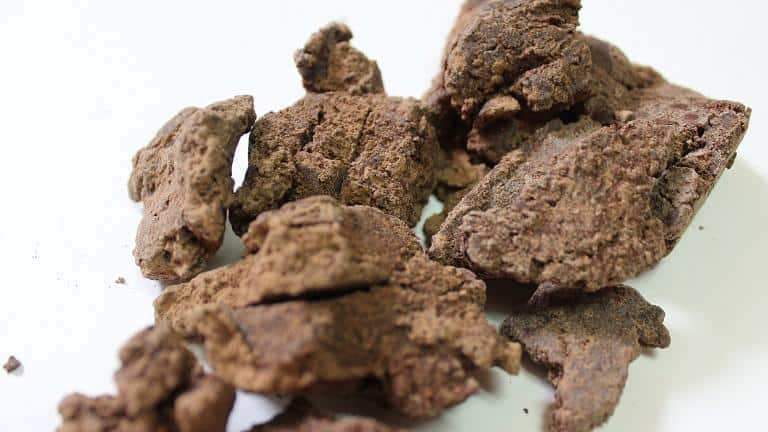
Jump To
Definition of Chocolate Liquor
Chocolate liquor is known by a bevy of names, including— but not limited to— cacao liquor, cacao mass, baking chocolate, cocoa liquor, cocoa mass, and even just "chocolate." But whatever you call it, this liquid is made from cacao beans (also called cocoa beans or cocoa nibs), and it contains both cocoa solids & cocoa butter in roughly equal measure.
Chocolate liquor is so called because many centuries ago, when the substance was being named, it was the liquid or fluid from which chocolate was being produced. This means that all chocolate bars contain some amount of chocolate liquor, then, right? Er, well, not quite.
Chocolates are all different, but there are three legally recognized types: milk, white, and dark. While milk and dark chocolates both contain some amount of chocolate liquor, by law a white chocolate contains only the cocoa fat, also known as cocoa butter.
Milk chocolate is actually a hybrid, because while dark chocolate is basically cacao + sugar, milk chocolates are based in lots of cocoa butter + sugar plus a bit of chocolate liquor & milk powder. But chocolate liquor delivers a lot more than flavor to the final product.
Since chocolate liquor is produced from cacao beans, it has the same nutrition profile, which includes high concentrations of magnesium and zinc, heart-healthy antioxidants, fiber, and some protein.

Definition of Chocolate Liqueur
On the other hand, chocolate liqueur is an alcohol flavored like chocolate. Some such examples are Creme de Cacao or Godiva Dark Chocolate Liqueur, both of which make use of cacao nibs to give them their characteristic flavors. Since there's no standard definition for a chocolate liqueur, over the decades, a variety of recipes have emerged.
Such companies' chocolate liqueur recipes seem to fall into two camps: cream-based or clear. Examples of cream-based chocolate liqueurs include Bailey's Chocolate Cherry and Mozart Dark Chocolate Cream Liqueur, while the most common clear chocolate liqueurs are variations of cremes de cacao.
If you're unfamiliar, crème de cacao is a chocolate-flavored liquor (usually artificially-flavored) made from a clear alcohol (usually vodka). It's quite common at bars, but not often found in a home bar setup, so if this is the first you're hearing of it, then you're probably not alone.
And if until now you had confused chocolate liquor with chocolate liqueur, you're also not alone. The two are so commonly confused that even Wikipedia name drops chocolate liquor as the "food ingredient made from fermented cocoa beans" for which chocolate liqueur is often mistaken.
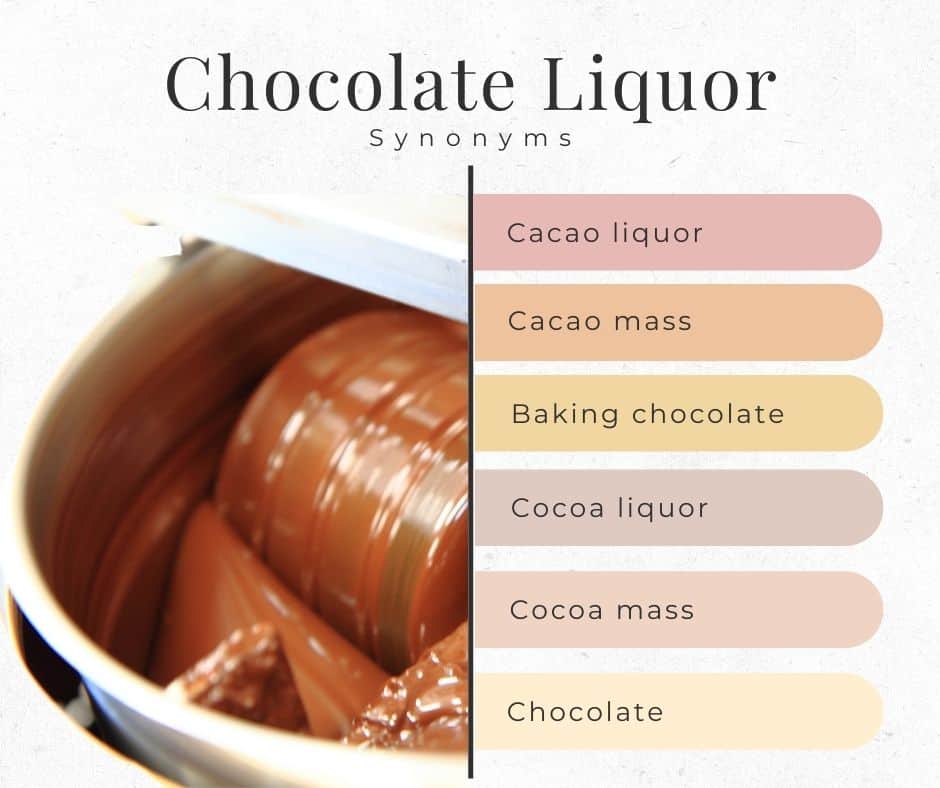
Chocolate Liquor or Cocoa Liquor?
Now not to throw a wrench in the great definitions above, but there is a third cacao product we should be considering here: cacao liquor. While chocolate liquor is pure chocolate in liquid form and chocolate liqueur is an alcohol-based chocolate beverage, cacao liquor is technically a fruit wine.
The chocolate tree, Theobroma cacao, actually only grows cacao fruits, whose seeds are harvested, fermented, and dried into the cacao beans that are made into chocolate (it doesn't actually bear finished chocolate bars).
But these fruits are quite juicy themselves, and some varietals produce more juice than others, way more juice than could possibly be needed to properly ferment the cacao seeds. So over time, farmers have taken to draining this cacao juice off the seeds and fermenting it separately into an alcohol commonly called cacao liquor.
Therefore, cacao liquor is best described as the fermented juice of the cacao tree, which tends to have a very sweet lychee-like flavor, crisp like apple cider. This is a delicious product that's quite hard to get off of the farm, but if you do run into it, know that it won't taste at all like chocolate.
So while cocoa liquor (aka cacao liquor) is actually an alcoholic liquor more comparable to a fruit wine, chocolate liquor is unsweetened liquid chocolate.
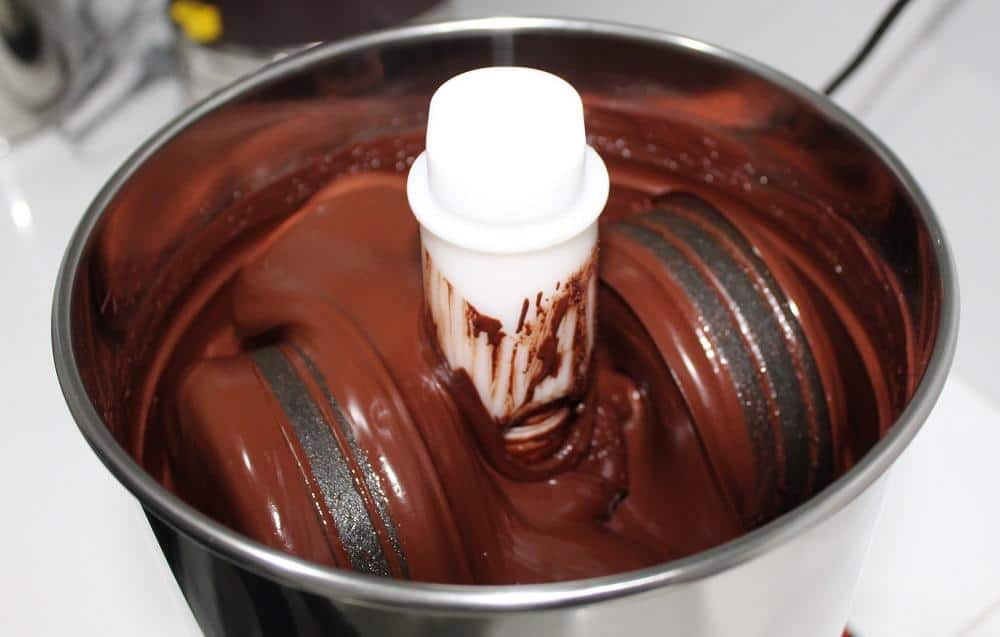
How Is Chocolate Liquor Used?
Chocolate liquor is used in a vast variety of goods, from ice cream and candy to coffee-based beverages, as it adds a rich, well-recognized flavor even in small quantities. It's also the base for both milk and dark chocolate; when the cocoa solids are removed, the cocoa fat is used to make white chocolate.
But most commonly, you know chocolate liquor by its more palatable name: baking chocolate. It's not to be confused with cocoa powder, which is basically a defatted version of chocolate liquor, usually containing less than 10% fat in commercial settings.
Food manufacturers usually source their chocolate liquor from a large cacao processor, a company whose name you'd have difficulty finding because they only work directly with other food companies.
These large cocoa processors often also sell other cacao-derived products, such as cacao nibs, whole beans, and cocoa powder & cocoa butter, to their manufacturing clients.
On the smaller side, chocolate liquor is also used in bean to bar chocolate making to assess the quality of a sample of cacao beans. The seeds are processed & prepared without sugar or milk, and then tasted closely in order to assess their potential without any flavor distractions.
Such test batches are quite small, usually just a few kilos or less, and most makers have several tests going at once in order to try different roasts and conche times.
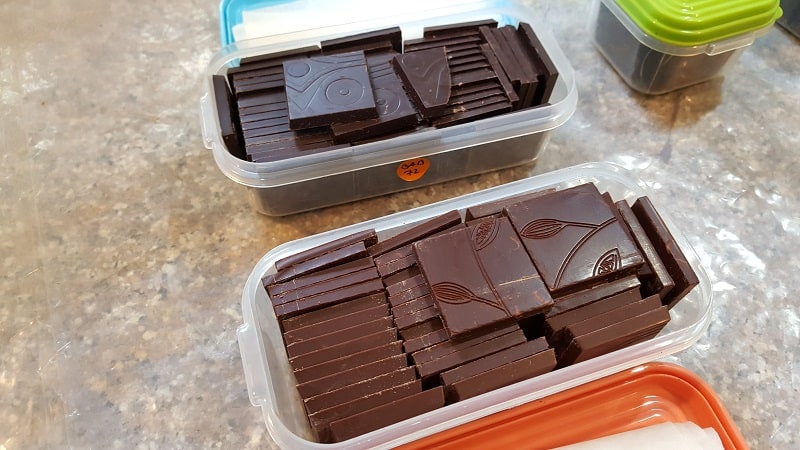
Homemade Chocolate Liqueur Recipe
For those of you looking to recreate something like the Godiva chocolate liqueur line— which seems to have done quite well for them over the years— this is the recipe for you. You can think of this like an alcoholic hot chocolate you can keep in the cupboard for special occasions.
By the end you'll have a bottle of cream liqueur with a strong chocolate flavor, perfect for that chocolate martini you want to make for dessert tonight (no? just me?). To start, you need to include an alcoholic base, like bourbon (whiskey), tequila, vodka, or really any grain alcohol you'd prefer.
I like the neutral flavor of vodka in any drink, but we all have opinions. Most people use vanilla extract + whole milk and sugar (or sweetened condensed milk) to add the vanilla + dairy undertone we expect from anything chocolate flavored.
I prefer to combine the two methods, because it seems to stay good longer than just milk and it more closely mimics the Godiva version.
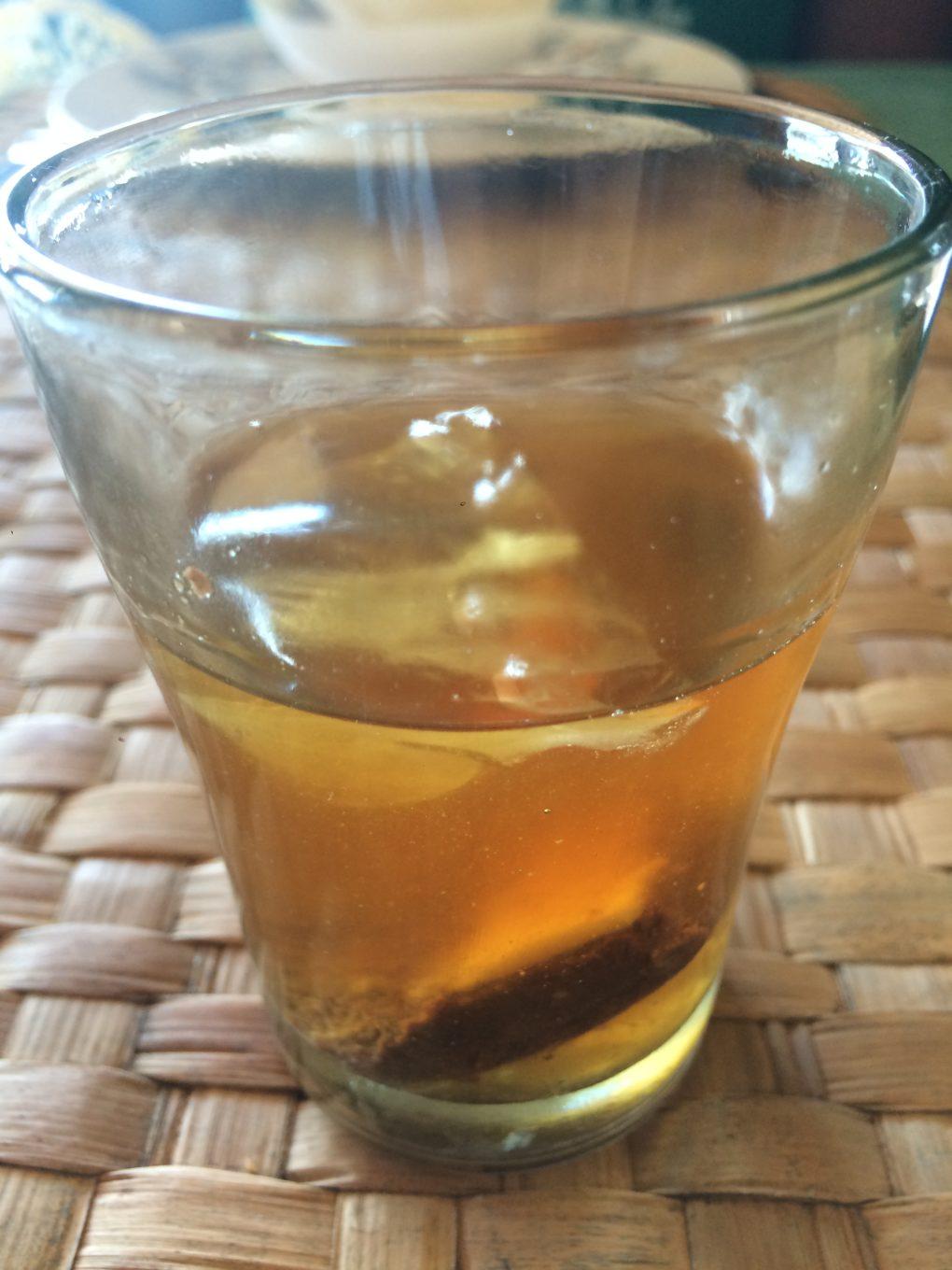
Chocolate Liqueur Ingredients:
- 2 cups/500ml clear liquor (I prefer vodka, but rum is also good)
- 2 teaspoons vanilla extract
- 3.5oz/100g of baking chocolate (1 large bar)
- 1 cup whole milk
- 1 can/14oz. sweetened condensed milk, room temperature (NOT evaporated milk)
To make this chocolate liqueur, simply heat your milk on low in a nonstick pot, until it just begins to simmer. While the milk is heating, chop the chocolate into thin slivers or small pieces; whichever is easier.
Once the milk is hot but not boiling, turn off the heat and immediately add the chocolate. Let it sit for two minutes, then slowly whisk the melty mixture together. Once the hot chocolate has melded together, slowly pour in the room temperature condensed milk, whisking to combine.
Finally, slowly add in the vanilla and then the chosen alcohol, mixing everything together as vigorously as possible. Refrigerate the mixture overnight or for several hours before serving, preferably over ice.
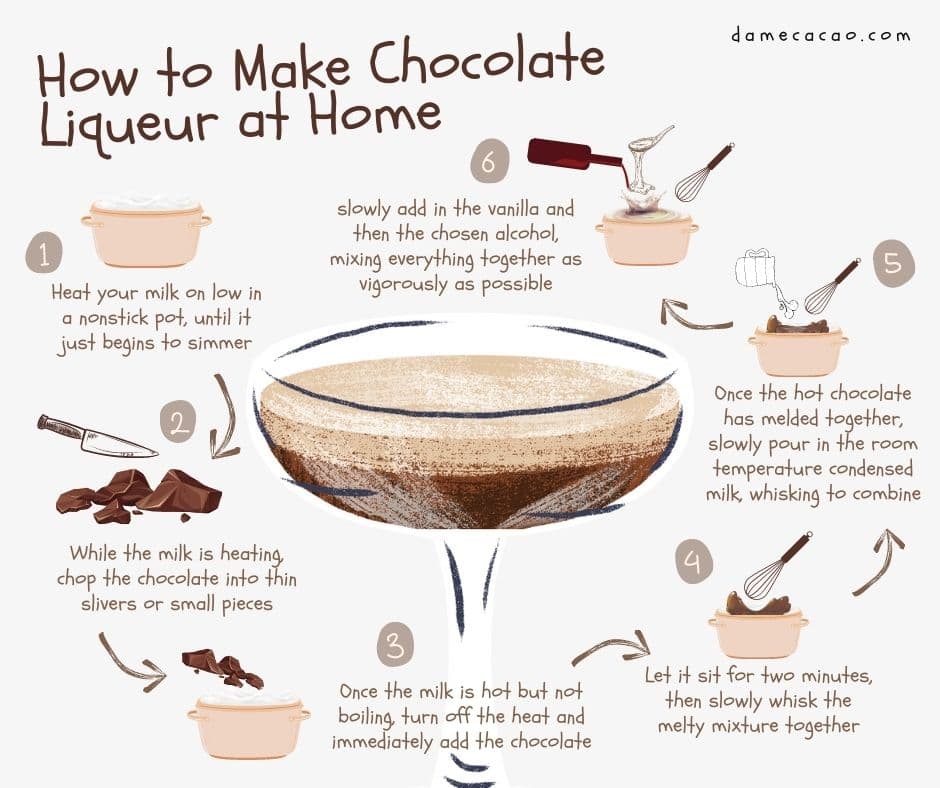
Chocolate Liquor FAQ
Yes. Chocolate liquor is made from the ground seeds of the cacao tree; therefore it is vegan friendly.
Yes! Chocolate liquor can make your dog or cat very sick. Keep them away from the chocolate liquor (& chocolate liqueur, for that matter).
Chocolate liquor is produced from ground cacao beans. The term is synonymous with cacao mass, baking chocolate, cocoa liquor, cocoa mass, and legally, even just "chocolate."
Nope! Chocolate liquor is produced from the humble cacao bean; the word 'liquor' being a more antiquated reference to the liquid state which the cacao must reach in order to be considered chocolate liquor.
Yes! All chocolate liqueurs contain alcohol, though chocolate liquor (produced from ground cacao beans) does not.
Pure chocolate liquor is gluten free (not to be confused with the alcoholic beverage 'chocolate liqueur,' which may contain wheat or traces of wheat).
Pure chocolate liquor is dairy free (not to be confused with the alcoholic beverage 'chocolate liqueur,' which may contain dairy).
Pure chocolate liquor is quite good for you. It's produced straight from the cocoa bean, which contains high amounts of fiber, protein, and mostly healthy fats. It also includes significant concentrations of magnesium, zinc, and heart-healthy antioxidants.
If this article on chocolate liquor left you with any questions, please leave a comment below!

















Stephanie wicke
The only chocolate that I can stand I are
ones that are made with chocolate liquor,but not all chocolate,milk or dark chocolate have liquor Listed in the ingredients. why is that? to me if they don't have the liquor in it then it tastes like fake chocolate. I know I'm fussy,but why isn't there a chocolate standard? thanks for listening.
Max
In the US, legally only milk chocolate and dark chocolate are required to contain chocolate liquor, and white chocolate only needs to contain cocoa butter. Unfortunately, these legal standards differ by country, so depending on your country's laws for standards of chocolate, some products may not contain cacao at all!
Edward Ward
Thank you so much for this educational article.
Max
My pleasure!
NWaller
Great all encompassing article!
Max
Thank you!
Carrie Masion
How long will this delicious concoction keep in the fridge?
Max
Up to two weeks safely!
Marge
I miss chocolate, I use to love it. But I can't find any without vanilla or Lecithin. I want dark and milk chocolate. Allergies are awful! Is there any hope for this chocolate lover? Can I find a plain chocolate?
Max
Yeah! Most good craft chocolates won't have vanilla or lecithins of any kind— I highly suggest checking out barandcocoa.com for some allergy-friendly options. ?
K
Do you have a recipe for Chocolate liquor? How do we go about making that?
Max
Hi, K! All you need is a small chocolate refiner and several hours, along with the nibs and/or whole cacao beans, preferably pre-ground into a thick paste. Alternatively, you can buy it.
Lorilyn
We have been enjoying a European marzipan bar coated in a thin layer of "chocolate liquor." I would like to try making a sugar-free keto version. Would melting unsweetened chocolate really yield that thin of a coating? Or is the ration of solids to cocoa butter different than 50:50 in this application? (In other words, would I have to add more cocoa butter?)
Max
Short answer: yes, you likely would need to add more cocoa butter.
More specifically: If it's coated in chocolate liquor, then it's technically also coated in unsweetened chocolate, so that would definitely be the right ingredient to use for your sugar-free keto version. And I think you're on the right path-- to be able to coat the bars of marzipan, the chocolate needs to be thinner but still stay solid at room temperature once they're set. Before you do a big batch, I'd recommend trying three different small versions of a few different chocolate blends, one with just the melted chocolate, one with the chocolate +1 0% cocoa butter, and one with the chocolate + 20% cocoa butter. Try taking a few plain almonds and dunking them in each of those, and seeing which final product looks the most correct. And don't worry if there's fat bloom; it's still perfectly fine to eat. Enjoy your marzipan, and happy baking!
Ray
Hi Dame Cacao: Thank you for this great walk through proper usage of chocolate terms. You use the term "legal" along with the terms dark chocolate, milk chocolate and white chocolate. Are you aware of actual laws establishing the compositions of the three chocolates? Would that it were so!! I've spent a couple of weeks in Asheville, NC and have found that all three of the prominent chocolatiers with stores downtown play fast and loose with the term dark chocolate: French Broad sells a bar (among other products) labelled dark chocolate that contains milk according to their own ingredients list. Same with Chocolate Fetish. Probably the most egregious would be Asheville Chocolates because they disclose pretty much nothing about what the consumer might be consuming upon purchasing any of their products. They have a vegan chocolate product leading me to assume it has no milk at all, but that's an issue of trust in what the individual clerk tells you because there's nowhere that ingredients are written down. Problem is that I have been presented with different ingredients from different clerks answering my questions about the same chocolate, so this one is the scariest for me.
Max
You're welcome, Ray. I do agree that it's frustrating to get untrue, careless, and contradicting answers from different producers. It should be possible to provide an ingredients list for every product, whether for health reasons or otherwise. It's a problem that needs to be addressed in part by customer complaints & requests, and in part by government regulation to back those requests. There are legal parameters for what foods can be labelled as chocolate, but unfortunately, those parameters do allow milk in products labelled as dark chocolate. However, milk in particular is required to be listed as an allergen on the label on any product commercially produced-- and if they don't have a very clear and confident answer for you, go elsewhere.